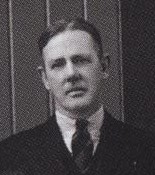
William (Bill) Martin Kelly (1892–1975), born in Westport, New Zealand was a rugby league football identity who enjoyed success in New Zealand and Australia as both a player and coach in the first half of the 20th century. He played for Wellington, the Balmain Tigers, New South Wales and for both the New Zealand and Australian national sides. He also had a long coaching career with five different clubs in the NSWRFL in the 1920s, 1930s and 1940s, and with New Zealand in 1932.

George Arthur Gillett was a New Zealand multi-code footballer of the early 20th century and a dual-code rugby international. Gillett died in 1956 in Onehunga.

The 1911–12 Kangaroo tour of Great Britain was the second ever Kangaroo tour and was actually a tour by an "Australasian" squad including four New Zealand players in addition to twenty-four Australian representatives. It took place over the British winter of 1911–12 and this time, to help promote the game of Rugby league in New Zealand, the Northern Rugby Football Union invited a combined Australian and New Zealand team. They became the first tourists to win the Ashes. and the last to do so on British soil for over half a century. The tour was a success in performance and organisation. Matches were well attended, the squad's touring payments were maintained throughout and the players all shared in a bonus at the tour's end.

William "Billy" Thomas Wynyard was a New Zealand rugby football player who was part of the professional rugby league 1907–08 New Zealand rugby tour of Australia and Great Britain.
Charles Dunning was a New Zealand rugby footballer who was part of the professional 1907–1908 New Zealand rugby tour of Great Britain.
Paddy Tuimavave is a former professional rugby league footballer who played as a fullback in the 1980s and 1990s and represented both New Zealand and Western Samoa.
The Rugby League Cup is a New Zealand rugby league trophy that is contested between districts on a challenge basis. The trophy used to be known as the Northern Union Cup.

The 1921–22 Kangaroo tour of Great Britain was the third ever Kangaroo tour. Again an Australasian side rather than an Australian team alone travelled to Great Britain to contest the Ashes. Coached by Arthur Hennessy and captained by Les Cubitt, the Kangaroos travelled on the RMS Tahiti to England for best-of-three series of Test matches against Great Britain for the Ashes. The tour took place during the 1921–22 Northern Rugby Football Union season and also featured matches against several of the clubs in that competition as well as other representative teams. The tour also involved some degree of player misbehaviour, with one young footballer almost sent home from San Francisco because of all the broken glasses following a drinking session on board the team's ship.
The 1909 New Zealand rugby league season was the second season of rugby league that had been played in New Zealand.
The 1910 New Zealand rugby league season was the third season of rugby league that had been played in New Zealand.
Riki "Dick" Papakura was a New Zealand rugby league player who represented the New Zealand Māori side and Australasia and played professionally for Warrington. His position of preference was at fullback or in the centres.
Ronald MacDonald was a New Zealand rugby league footballer who represented New Zealand between 1909 and 1911.

Arapeta Paurini Wharepapa, or Albert Asher as he was more commonly known, was a New Zealand dual-code international rugby union and professional rugby league footballer who played in the 1890s, 1900s, 1910s and 1920s. At representative level Asher played rugby union for New Zealand, North Island and Auckland playing on the Wing and played rugby league at representative level for Australasia, New Zealand, Auckland and the New Zealand Māori rugby league team. One of his brothers, Ernie, was also a rugby league international while another, John, became a Ngati Pukenga and Ngati Pikiao leader, and another brother, Thomas also played representative rugby for Tauranga. Katherine Te Rongokahira Parata was a sister.
The Australasian rugby league team represented Australia and New Zealand in rugby league sporadically between 1910 and 1922. Administered by the New South Wales Rugby League, appearances for the team were counted towards the Australian team's records and playing register but not the New Zealand team's. The team toured Great Britain twice, participating in two Ashes series, and also played Great Britain twice in Sydney.
Puhipi James Rukutai was a New Zealand rugby union and professional rugby league footballer who played representative rugby league (RL) and coached New Zealand. The Auckland Rugby League's minor premiership, the Rukutai Shield, is named after him.
Robert Tubman was a pioneer Australian rugby league footballer, one of his country's first selected national representatives.
John David Smith is a New Zealand former rugby league footballer who represented New Zealand in the 1975 and 1977 World Cups.
The 1926–27 New Zealand rugby league tour of Great Britain was a tour by the New Zealand national rugby league team. The team lost a series 0–3 against the Lions and also lost a test match against Wales. The toured was marred by player dissatisfaction and a strike involving seven players.
The 1909 New Zealand Māori rugby league tour of Australia was a tour made by a group of New Zealand Māori rugby footballers who played rugby league matches in Queensland and New South Wales. The tour followed on from another Māori tour of Australia the previous year and a tour by the New Zealand national side a month earlier. The Māori side played the Australian national side four times, winning one of the "test" matches.
Hohepa Joe Rātima is a New Zealand rugby union and professional rugby league footballer who played representative rugby league (RL) for New Zealand.









